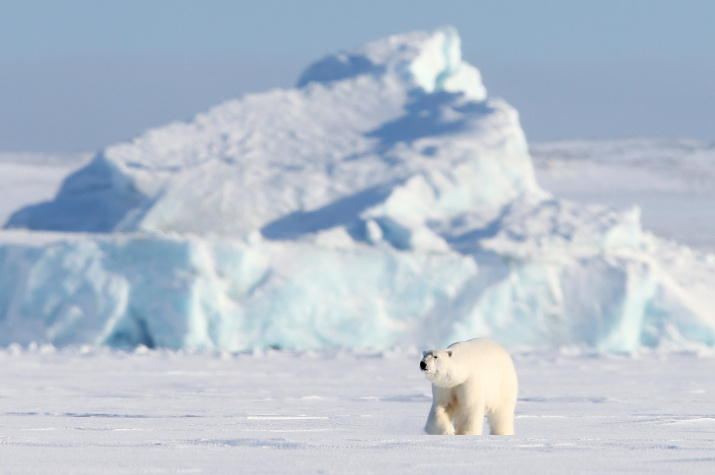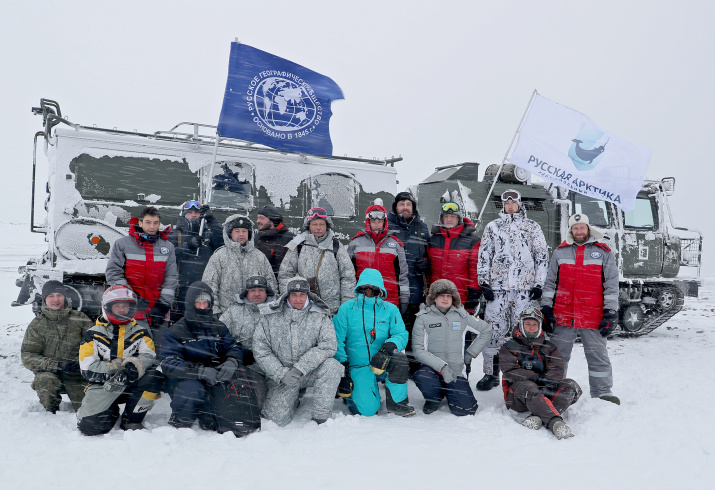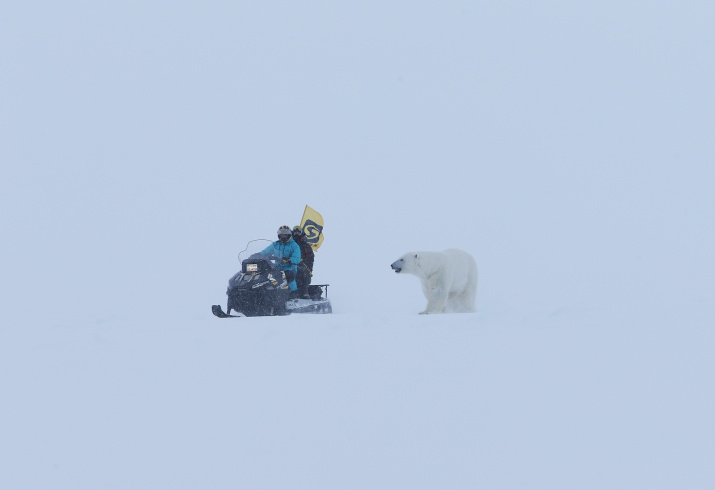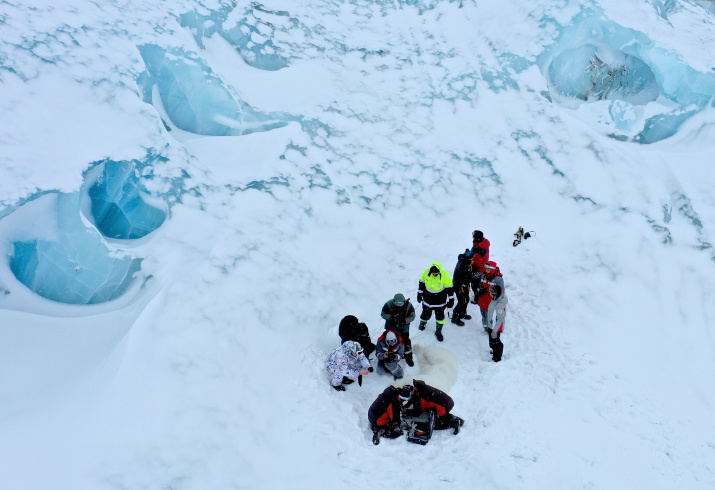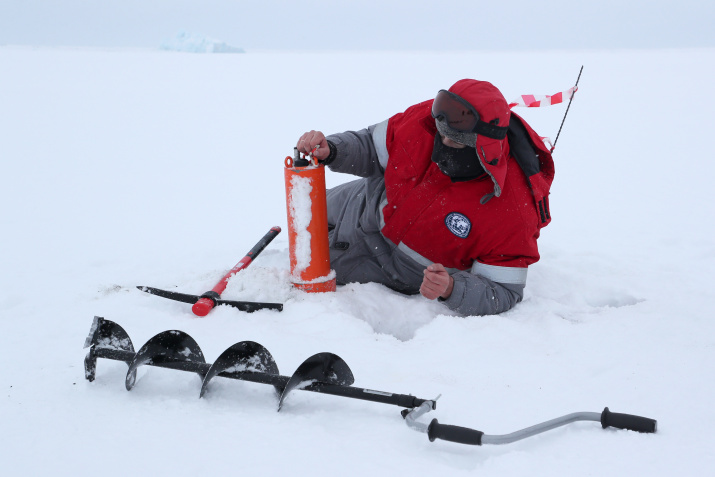The current visit of the scientists to the island of Alexandra Land (part of the Franz Josef Land archipelago) was a continuation of a large-scale project to study biological diversity in the Arctic. This year, for the first time, the expedition included geophysicists, geologists, seismologists, creologists and oceanologists, which gave the research an interdisciplinary character. The scientists are mainly interested in how global climate change affects all aspects of life in the Arctic and what needs to be done to preserve its unique ecosystem.
While the bear is sleeping ...
The main goal of the expedition, which took place from March 26 to April 10, was to observe polar bears. The scientists from A.N. Severtsov Institute of Ecology and Evolution of RAS and specialists of the “Russian Arctic” National Park have been occasionally working together since 2009, and on an ongoing basis since 2018. Only through continuous change, collecting annual data on the species, can the scientists draw conclusions on the current state of the population and trace the population dynamics. Biologists got the opportunity to conduct long-term observations thanks to the support of the Russian Geographical Society.
Franz Josef Land is considered the "maternity hospital" of the polar bear. The numerous islands of the archipelago, surrounded by ice even in the summer months, with a large number of bird colonies, an abundance of seals and walrus haulouts, are an ideal habitat for the polar predator.
According to the head of the biologists group from A.N. Severtsov Institute, Ilya Mordvintsev, the central part of the island and its northern coast from Zveroboev Bay to Ilaev Bay and Nimrod Cape had been explored. The main search routes passed along fast ice in Dezhnev Bay. The researchers covered over 850 km on snowmobiles. The northern coast of the island is ice-free. Seals and a haulout of five Atlantic walruses were seen at the water's edge, as well as birds – guillemots and little auks.
This year, the weather presented an unpleasant surprise. For almost the entire second half of the expedition, there was heavy snow and a blizzard. In such weather, bears try not to leave their hiding places. Nevertheless, the biologists were able to find one den and traces of a female with cubs, as well as capture four males. They were weighed and biomaterials were taken for genetic, biochemical and toxicological analyses.
“To carry out the necessary research, a bear is immobilized – they are shot with a tranquilizer ampule from a special gun,” explains Marina Menshikova, a representative of the “Russian Arctic” National Park. “This safe method is used by scientists all over the world. While the animal sleeps (no more than 15 minutes), the scientists need to take a blood sample to test for the content of erythrocytes and leukocytes. Later, in the laboratory, which is deployed right in the Arctic, hormones in the blood are tested as well. And in the Moscow laboratory, the blood will be studied by the geneticists. In addition, the bears are measured, weighed and ear-tagged with the date of tagging and the name of the place where it was captured. After all the manipulations, the bear is injected with a special agent that helps it to awaken as soon as possible.”
The preliminary findings are encouraging. The bears from Alexandra Land Island are healthy and well-nourished. Therefore, they are not experiencing nutritional problems.
Nevertheless, zoologists want to make sure that the data obtained reflects the state of the entire population of polar bears on the island. There are also plans to install special collars on females to record the migration routes of the animals. That is why a group of scientists will continue their work on Alexandra Land after the end of the expedition.
“The polar bear in the Arctic is at the head of the food chain,” sums up the director of the “Russian Arctic” National Park Alexander Kirilov. “By observing it, the biologists can track trends on a much larger scale. These are climate changes, anthropogenic influence in the region and the spread of new species in the Arctic as a whole.”
Interdisciplinary effect
The biologists aren’t the only ones interested in large-scale trends. And this year, the scientific staff of the complex expedition was significantly expanded.
For the first time in history, the Alexandra Land Island was studied by geophysicists, seismologists, oceanographers and permafrost specialists. They have different goals in their own research, but a common logic. The scientists are interested in how the Arctic behaves in the face of climate change, what challenges may arise in the foreseeable future.
Leonid Ostroumov, who headed a group of researchers from N.N. Zubov State Oceanographic Institute, said that participation in the expedition allowed the scientists to understand the possibilities of determining sea level using the GLONASS system. This is primarily a matter of public safety, the scientist emphasizes.
The accuracy of sea level changes and its dynamics is extremely important, for example, for predicting flooding, for the construction of facilities on the coast, as well as for the country's defense. By the change in sea level in the oceans, one can judge whether global warming is occurring, and if so, how critical its consequences may be for humanity.
Scientists agree that we are living in an era of rapid change, especially in the Arctic. To understand their vector, one needs both a systemic monitoring of the processes taking place today and a retrospective look. Permafrost and the cryosphere in general (the geographic cover of the Earth, where the temperature is mostly below zero) give researchers such an opportunity.
As stated by Robert Sysolyatin, the head of the group of specialists from the Melnikov Permafrost Institute of the Siberian Branch of the Russian Academy of Sciences, permafrost on Alexandra Land had never been studied by anyone before. Meanwhile, it is a kind of encryption of centuries-old natural changes.
His colleague from the Institute of Earth’s Cryosphere of the Siberian Branch of the Russian Academy of Sciences, Evgeny Babkin, explains that temperature sensors installed at different depths will record changes in the temperature of permafrost. After three years, it will be possible to draw a conclusion about climate fluctuations.
The specialists of Schmidt Institute of Physics of the Earth of RAS also worked on Alexandra Land for the first time. In particular, the microseismic sounding of the seabed from the ice surface in the Arctic was tested in the field.
“If seismic sensors are installed on drifting ice, they can become a “locator” scanning the seabed topography and providing information about any bodies or objects in the thickness of the under-ice water,” says Ruslan Zhostkov, senior researcher at the Laboratory of Fundamental Problems of Environmental Geophysics and Volcanology of the Institute of Physics of the Earth.
The scientists photographed part of the island's territory from the air. A set of images, with subsequent computer processing, will make it possible to create an otrophotoplan – a kind of three-dimensional image of the relief on an accurate geodetic basis. It can be used to analyze the earth's structure – for example, to identify folds and cracks.
Perhaps the main feature of the current expedition is its interdisciplinary interaction. It obviously enhances the research effect. Geophysics goes hand in hand with geology; theoretical geodesy, with oceanography; biology, with ecology.
Now, when the field part of the work is done, begins the stage of decoding and interpreting the results. Based on geophysical data, it will become clear whether there is a seismic rupture in the area of one of the bays of Alexandra Land Island. If the assumptions of the scientists are confirmed, it will mean that a strong earthquake happened here earlier. And it can happen again.
Numerous samples of water, ice, soil and biomaterial were sent to the laboratory. This will make it possible to assess the state of the environment and fauna, the degree of human activity impact on them. And also make a forecast and formulate recommendations.
Arctic without mistakes
The Arctic region is becoming the center of attention more and more often. This is due to the large reserves of mineral raw materials and promising transport corridors in the waters of the seas of the Arctic Ocean. However, the Arctic still remains a poorly studied natural complex due to its remoteness, inaccessibility and difficult weather conditions. All this limits the periods of scientific research.
At the same time, it is the Arctic, and above all its fauna, due to the still limited human impact, that is an indicator of global climate change.
The results of the scientists’ work in the framework of the “Umka-2021" expedition are extremely important in the light of the economic development of the Arctic. This, apparently, is what awaiting the region in the foreseeable future.
In the past, almost everywhere on the planet where economic activity began, gross and sometimes criminal mistakes were made in relation to nature. For the sustainable development of the Arctic, it is important now to take into account that negative experience and try to avoid its repetition. This is the mission of Russian scientists working today in the Arctic.
For reference
In December 2010, during the expedition of A.N. Severtsov Institute of Ecology and Evolution of RAS to Franz Josef Land, Vladimir Putin put a collar with a satellite transmitter on a polar bear. From that moment on, the topic of studying this Red Book animal in the Russian Arctic has become one of the priorities for the Russian Geographical Society.
In 2013, the Russian Geographical Society supported an international expedition to Franz Josef Land, during which a large team of scientists for the first time collected comprehensive scientific data on the state of the archipelago's biological diversity.
In 2013–2015, the “Russian Arctic” National Park received a grant from the Russian Geographical Society to study the role of the “Franz Josef Land” Reserve in the conservation of populations of rare species of marine mammals and polar bears.
Since 2018, with the support of the Russian Geographical Society, biologists have been studying the health status and seasonal movements of the animals every spring.
Over the past three years, scientists have constantly been part of the complex expeditions of the Russian Geographical Society and the Northern Fleet in the waters of the Arctic Ocean and on its islands. In the course of previous expeditions, a number of important scientific discoveries was made, including in the field of the current state of rare species of marine mammals.
Aivar Valeev

